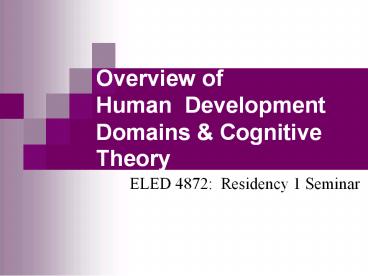Overview of Human Development Domains - PowerPoint PPT Presentation
1 / 9
Title:
Overview of Human Development Domains
Description:
... birth to 2 years Early childhood: ... 12-19 years old Domains of Development Development is described in three domains, ... Social/Emotional Domain: ... – PowerPoint PPT presentation
Number of Views:216
Avg rating:3.0/5.0
Title: Overview of Human Development Domains
1
Overview of Human Development Domains
Cognitive Theory
- ELED 4872 Residency 1 Seminar
2
Child Development
- Definition
- Change in the child that occurs over time.
Changes follow an orderly pattern that moves
toward greater complexity and enhances survival. - Periods of development
- Prenatal period from conception to birth
- Infancy and toddlerhood birth to 2 years
- Early childhood 2-6 years old
- Middle childhood 6-12 years old
- Adolescence 12-19 years old
3
Domains of Development
- Development is described in three domains, but
growth - in one domain influences the other domains.
- Physical Domain
- body size, body proportions, appearance, brain
development, motor development, perception
capacities, physical health. - Cognitive Domain
- thought processes and intellectual abilities
including attention, memory, problem solving,
imagination, creativity, academic and everyday
knowledge, metacognition, and language. - Social/Emotional Domain
- self-knowledge (self-esteem, metacognition,
sexual identity, ethnic identity), moral
reasoning, understanding and expression of
emotions, self-regulation, temperament,
understanding others, interpersonal skills, and
friendships.
4
Theories
- What is a theory?
- Orderly set of ideas which describe, explain, and
predict behavior. - Why are theories important?
- To give meaning to what we observe.
- As a basis for action -- finding ways to improve
the lives and education of children.
5
Cognitive Theories
- Beliefs that describe how children learn
6
Jean Piaget
- Cognitive development theory
- Children "construct" their understanding of the
world through their active involvement and
interactions. - Studied his 3 children to focus not on what they
knew but how they knew it. - Described children's understanding as their
"schemas and how they use - assimilation
- accommodation.
7
Piagets Cognitive Development Stages
- Sensori-motor
- Ages birth - 2 the infant uses his senses and
motor abilities to understand the world - Preoperation
- Ages 2-7 the child uses metal representations of
objects and is able to use symbolic thought and
language - Concrete operations
- Ages 7-11 the child uses logical operations or
principles when solving problems - Formal operations
- Ages 12 up the use of logical operations in a
systematic fashion and with the ability to use
abstractions
8
Lev Vygotsky
- Socio-Cultural Theory
- Agreed that children are active learners, but
their knowledge is socially constructed. - Cultural values and customs dictate what is
important to learn. - Children learn from more expert members of the
society. - Vygotsky described the "zone of proximal
development", where learning occurs.
9
Information Processing Theory
- Uses the model of the computer to describe how
the brain works. - Focuses on how information is perceived, how
information is stored in memory, how memories are
retrieved and then used to solve problems.





























